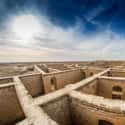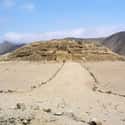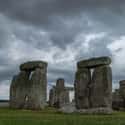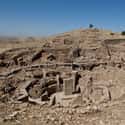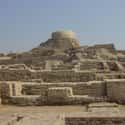-
(#1) Ancient Egypt
Mystery and intrigue have surrounded the ruins of Ancient Egypt for several millennia. Around 3,000 BCE, people began to congregate along the lower Nile River and soon created one of the greatest civilizations in human history. Their cultural output, their riches, and their engineering astounded the ancient world.
The Egyptians boasted a complex hieroglyph writing system, developed a sophisticated mummification process, and created incredible monumental structures that have survived to this day.
Some of Ancient Egypt's most well-known structures are the Pyramids of Giza - the largest of which, the Pyramid of Khufu, is the only remnant of the Seven Wonders of the Ancient World. It has a base of 756 feet, and when originally built, reached 481 feet in height. It was the tallest human-made structure for more than 3,000 years of recorded history.
The immense Pyramid of Khufu is even more incredible when considering it was made by the precise placement of stones that could weigh more than 60 tons. Historians don't completely agree on how the Egyptians made the pyramids, or the size of the workforce required to build them, but there are many theories. Since the Egyptians did not have crane technology, some historians theorize the Egyptians used ramps. Others, however, claim this would be impractical; the stones would be too large, the ramps too long, and the workforce too small to do this in a timely manner.
Instead of ramps, others believe the Egyptians developed a complex hydraulic system, as suggested by the intricate shafts in the pyramid's interior and the high water table inside the Pyramid of Khufu.
Regardless of how the pyramids were made, the Ancient Egyptians were a highly advanced society and became the jewel of the ancient world, so much so that they became a target of envy and military domination.
-
(#2) The Mayans
The Mayans were (and still are) the indigenous people of Mesoamerica, and their society was complex politically, culturally, and scientifically. Established millennia before European contact, around 2000 BCE , the Mayans were not a singular entity but a cultural group that can be divided into different eras.
Various hegemonic political powers and independent city-states rose and fell throughout the culture's history, during which Mayans developed certain systems and technologies far more advanced than those in the Old World.
Very early in their history, the Mayans began their own hieroglyphic writing system, complex mathematics, and a calendar system far more accurate and detailed than anything else around the world. By watching the stars, the Mayans devised three calendars that worked in tandem: the Haab (a 365-day civil calendar divided into 18 months), the Tzolkin (a sacred calendar with 260 days divided into 3 periods), and the Long Count Calendar (a calendar used for lengthier calculations of time.)
Around 1000 BCE, the Mayans began building pyramids. These monumental buildings towered over the Central American rainforests, and their architecture was designed with their astronomy and time-keeping in mind. One of the most well-known Mayan pyramids, Chichen Itza, has steps running from its base to the top on each of the pyramid's four sides. Each set has 91 steps, which total 364 - or 365, if you consider the final step into the pyramid.
Despite the society's complexity, the entire civilization collapsed between the 8th and 9th century CE, leaving many of their expansive cities completely abandoned. Historians, archaeologists, and laymen have proposed many theories for their sudden disappearance, including deforestation, drought, and foreign incursion, but none have been determined for certain.
-
(#3) The Rapanui
Some 2,300 miles off the coast of Chile is a small island called Rapa Nui, also referred to as Easter Island, originally settled by migrating Polynesians between 300 and 400 CE. They developed a rich culture, evident by the 900 or so enormous stone figures scattered around the 63-square-mile island.
Often mounted atop stone platforms called ahus, these stone statues, or moai, were chiseled from tuff, a porous volcanic rock. Though they were obviously used for a ceremonial purpose, historians and archaeologists have no idea what specific role they played, why the Rapanui made such a large quantity, or how they managed to move them. Each moai is about 32 feet tall and weighs about 82 tons.
Historians suggest the Rapanui cut down palm trees and used those logs to transport the stone heads. Regardless of whether or not that was the method, making and transporting the moai would have taken great amounts of manpower.
Based on how barren the island is now and the erosion that has taken place, it's theorized that the Rapanui left a huge ecological effect on the island, which may have caused the entire civilization to collapse. By wiping out most of the island's palm trees and replacing them with agricultural land, most of the nutrient-rich soil eroded. Without that soil, the crops dwindled, and in the ensuing years the island's population struggled through intermittent periods of conflict and peace.
-
(#4) Sumer
Sumer is considered the "cradle of civilization" due to it being one of the earliest cultures to appear on the historical scene. It is unclear when the first Sumerians migrated between the Euphrates and Tigris rivers, but by 3600 BCE, they'd created the world's first cities, including Ur, Eridu, and Uruk.
The development from primarily small settlements to cities was a slow, thousand-year-long process, and the Sumerians depicted this transformation in a cuneiform document from 2100 BCE called the "Sumerian King List." It is described as a period in which the gods and Sumer's kings were able to triumph over chaos. During this time, the society created systems and inventions to harness or counteract the harsh conditions of what is now modern Iraq, including irrigation, the wheel, and sailboats.
Despite adapting technology to allow society to grow larger than ever before, Sumer's greatest achievements occurred around 2000-1750 BCE, in a period that was later named the Sumerian Renaissance. During this period, the Sumerians created basic standards that are taken for granted today, including the concept of time.
The Sumerians had a duodecimal and sexagesimal counting system (meaning they had a 12-based and 60-based counting system, rather than the decimal 10-based system used today) and divided the days by the same system.
The Sumerians also created the world's first legal code, named after the Babylonian king who created it, Hammurabi. Hammurabi's Code provided the basis for city and legal administration by defining rules that every citizen must abide by.
-
(#5) Caral Civilization
Though the most well-known civilization to come out of Peru was the Incan Empire, it was only an established empire between 1438 and 1533 CE. Yet their Andean roots can be traced back far into antiquity. The Caral civilization (c. 3000-1600 BCE), the Nazca civilization (c. 200 BCE-600 CE), and the Inca each had distinguishing features, yet all were able to establish largely populated metropolitan states in a geographically difficult region.
Each of these civilizations was located on the world's longest above-water mountain range, the Andes. The range spans across seven different modern countries on the western end of South America and is about 500 miles wide from its most western point to its most eastern. Its peaks are the third tallest in the world, with only the Himalayas and the Hindu Kush taller.
Despite living in such difficult terrain, the native people established one of the earliest civilizations in human history. The city of Caral spanned 35 square miles, boasted 17 pyramid complexes (with pyramids that spanned the size of four football fields and rose 60 feet tall), and became a center for trade in the region.
Recent archaeological excavations have found evidence that the people in Caral farmed squash, beans, and sweet potatoes, but no storable grains. More remarkable, however, are the remains of sardines, anchovies, and shellfish, which archaeologists believe came from a 14-mile trek across the Andes from Caral's city center to the ocean.
Despite these achievements and extraordinary success, the civilization mysteriously collapsed in 1600 BCE.
-
(#6) The Celts (Or Their Neolithic Predecessors)
Originating from central Europe around 1200 BCE, the Celtic people spread across Western Europe and established themselves as a dominant cultural group in the region. However, they did not remain a monolithic people. Modern-day France, Ireland, and Britain were once populated by different Celtic groups, such as the Britons, Caledonians, and Galatians.
Though they made up a large part of Western Europe, and eventually the Roman Empire, the Ancient Romans commonly wrote these people off as "barbarians" who were "unfamiliar with the use of clothing," as an ancient commenter wrote.
The 17th-century archaeologist John Aubrey theorized that, despite being highly criticized by the Romans, Celt Druids were able to build an incredible structure on the southern end of Britain, Stonehenge. The circular earthwork has a total diameter of 360 feet, and is made up of about 50 sarsen stones that are about 13.5 feet tall, 7 feet wide, and weigh about 25 tons each.
Aubrey's claim has been challenged by others who say the giant structure predates the Celts by 1,000 years and may have been built by multiple Neolithic tribes who contributed to different steps of the construction process.
Whether built by the Celts or their Neolithic predecessors, their construction method remains a mystery, as does the purpose behind Stonehenge. There are several historical theories for both, including:
- Builders used logs to roll the stones.
- They used levers and weights to lift them.
- It was built for ceremonial purposes.
- It was built for time-keeping purposes.
-
(#7) Ancient Turks
In Southeastern Turkey resides what may be the oldest human-made temple in history, Gobekli Tepe. Dated to around 9000 BCE, prehistoric people gathered around 300 seven-to-10-ton stones at the highest peak of a mountain ridge that rises 1,000 feet above the surrounding valley. There, the ancient builders arranged what archaeologists believe was a religious temple.
The structure itself is built from four arrangements of monolithic pillars, each encircled by smaller stones. Many of the stones are elaborately decorated with carved foxes, scorpions, lions, and other animals, along with more abstract designs. The most prominent, however, are carvings of vultures, which archaeologists believe to be representations of death.
Gobekli Tepe is still shrouded in mystery. Only 5% of the site has been excavated, but what has been found predates metal tools, pottery, the wheel, and agriculture. Archaeologists believe it was created by a hunter-gatherer society, but the organization and the tools needed to build Gobekli Tepe do not align with contemporary theories about how early hunter-gatherer societies functioned.
In the surrounding area, evidence suggests humans were beginning to domesticate sheep, pigs, and cattle 1,000 years after Gobekli Tepe was erected, thus putting them at the forefront of the agricultural revolution. But there is also no evidence of permanent housing, which has led historians to believe it could have been a pilgrimage site rather than a permanently settled temple.
-
(#8) The Kingdom Of Zimbabwe
On the southern end of modern Zimbabwe are the ruins of Great Zimbabwe, a 1,779-acre fortress city that towers above the Limpopo and Zambezi Rivers. Built around the 10th century by the Shona, a Bantu-speaking people native to South Africa, this city housed an estimated 18,000 people in what may have been the capital of a much larger empire.
The cities surrounding the mountains contain more than 4,000 gold mines and 500 copper mines, which some historians estimate produced 40% of the world's gold during the empire's height (between the 11th and 14th century CE). Evident from many non-African goods found within the city, Great Zimbabwe was a center of trade connecting the Middle East and South Asia to Central and Southern Africa through the Mozambique coast.
Only 2% of the entire city has been excavated, but its walls are already considered a marvel of ancient engineering. The 36-foot-tall wall surrounds the entire city, but there is no mortar keeping the stones in place. Despite having no binders, the majority of the wall, as well as the towers and turrets around the city, has stayed intact for more than eight centuries.
This building technique was not limited to the city's defenses. In the city center is a tower measuring 32 feet high and 820 feet in circumference, and made of 900,000 pieces of granite, each sliced with professional precision. These, too, are stacked without any form of binder to keep them in place. The tower is surrounded by soapstone sculptures depicting bird-like creatures that have human lips and feet.
Europeans who encountered Great Zimbabwe in the 19th century could not believe the Shona or any other Bantu people - who had abandoned the city in the 15th century and dispersed into smaller settlements - could have built this engineering wonder. They instead theorized foreigners – Persian, Portuguese, Chinese, or Arab – traveled to Zimbabwe to create this city, but that was proven false by a British archaeologist in 1905.
-
(#9) Ancient Greece
Ancient Greece was a collection of city-states that shared a single culture. Often considered the birthplace of Western civilization, Ancient Greece created the foundations for Western philosophy, literature, mathematics, history, drama, art, and government.
During the 4th and 5th centuries, the Greeks developed a form of artistic realism that allowed artists to sculpt harmonious, realistic, and beautiful renditions of the human figure out of marble and bronze. Artist Polykleitos of Argos formulated a system of proportions that was particularly influential at the time. Such realism was almost completely unseen in the rest of the ancient world, and the knowledge was lost for almost a millennium until it was rediscovered during the Renaissance.
In the 5th century, philosopher and mathematician Pythagoras formulated a mathematical theorem that would always be able to calculate the lengths of any right triangle (a^2+b^2=c^2). Taught today in high school geometry classes, the Pythagorean Theorem established the foundation for more complex engineering, navigation, and astronomy.
In the same century, Democritus theorized that all matter is made of small, indivisible structures called atoms. Despite being unable to see or go beyond the theoretical, his theory was largely proven to be true 1,400 years later and became the basis of modern atomic theory.
The Ancient Greeks built colossal monuments, some of which still stand to this day. In Athens, there was the Acropolis, a 7-acre compound that rises 490 feet above the rest of the city and housed its religious temples. The Mausoleum at Halicarnassus was a 104-foot by 85-foot marble funeral monument adorned with 6-foot high marble statues. The Colossus of Rhodes was a 108-foot statue of the sun god Helios who stood above the city's harbor.
Of the Seven Wonders of the Ancient World, five of them had Ancient Greek origins.
-
(#10) Indus Valley Civilization
Along the Indus River in modern-day Pakistan, Afghanistan, and Northwestern India, arose one of the earliest human civilizations, the Indus Valley Civilization. Also known as the Harappan, the Indus Valley people flourished in the region for about 2,000 years between 3300 BCE and 1300 BCE and established 500 discovered settlements throughout the entire region.
Despite being such an important civilization to the history of human development, much of it remains a mystery. Archaeological evidence suggests the civilization was incredibly complex: they invented irrigation and drainage systems, a standardized weight and measurement system (useful for trade), sprawling urban centers, and a written language that has yet to be deciphered.
Modern historians and archaeologists have no idea how the society functioned or what happened to it. There are very few written records, no statues or monuments of kings or conquerors, and no depictions of any war or battles.
The most well-known settlement of the Indus Valley Civilization is the city of Mohenjo-Daro. The city itself was larger and more advanced than most other cities of the time; it was built using clay brick on a well-coordinated grid, housed 40,000 people, and below it was a sophisticated drainage and water management system that allowed every home its own bath. Despite public baths with underground furnace systems, assembly halls, marketplaces, and ancient apartment buildings, there is no building that indicates a seat of power or central governance.
The people and their cities remain a mystery, as does the reason for the civilization's collapse. Around 1700 BCE, the civilization seemingly disappeared without any trace. Historians have theorized the civilization dispersed from sprawling urban centers after a major shift in staple crops from wheat and barley to rice and millet. Yet the reason for the decline is still heavily debated.
-
(#11) North American Mound Builders
There are few remnants of native sedentary societies in North America, but those that did construct large, well-established cities left behind a unique cultural practice: mound building. In both the Ohio Valley and the Mississippi Valley are remnants of human-made mounds ranging in height, width, length, and even shape, including a serpent-shaped mound in Ohio appropriately named Serpent Mound.
The largest concentration of these mounds is a plot of land in Southern Illinois in what may have been the largest pre-Columbian settlement north of Mexico, Cahokia. Historians believe the 190 mounds were platforms for an agriculture-based sedentary society that flourished between 1050-1200 CE. It's thought to have had a population of 10,000-20,000 people.
This kind of settlement was anomalous on a continent primarily populated by either semi-sedentary or nomadic peoples, but historians have attributed their unprecedented growth and size to a period of warmer temperatures. Historians and climate scientists suggest that within those two centuries, the Earth's climate was unusually warm. This resulted in increased rainfall, which allowed an agricultural society to flourish when it wouldn't have otherwise.
However, Cahokia's success was short-lived. In 1200 CE, archaeologists believe the city fell into decline until it was struck by a major flood in 1400 and was abandoned.
The remnants of the city have provided modern researchers with evidence of an incredible society. The largest of the 190 mounds is "Monks Mound," whose four terraces rise 100 feet above the surrounding plains. The mound itself measures 17 acres at its base, but archaeologists have found postholes at the top of Monks Mound, suggesting the Cahokians built a wooden temple on it.
Monks Mound may have been the center of an extensively well-planned city. Every neighborhood, plaza, causeway, and mound sits on a city grid oriented with the Sun's pathway during Summer Solstice. Cahokians also created a Woodhenge, presumably as a way to tell time, played a game called "Chunkey" - though historians and archaeologists don't know what the rules of the game were - and practiced human sacrifice.
Though there are no written records, it's obvious to archaeologists that Cahokia had an intricate religion based on cosmological change, due to how the city was aligned with different celestial bodies.
-
(#12) Ancient Rome
Though Rome began as a small city-state on the Tiber River around 750 BCE, it grew into an empire that spanned first the entire Mediterranean and then large parts of Western Europe as well. Ancient Rome was incredibly adaptable to foreign ideas and was often willing to improve upon them - maybe not in the aspect of intellectual theory, but in practice.
There is a common proverb that "all roads lead to Rome." Though it's meant to be a figurative way of explaining there are multiple ways to get to a certain conclusion, there is also a very literal truth to it, and serves as a testament to the empire's civil engineering: all roads did, in fact, lead to Rome.
Beginning very early in their history, the Romans began building roads that connected major cities, similar to a modern highway system. The road connecting Capua to Rome, called the Via Appia, covered 121 miles and took the straightest possible path. The Romans built gravel and cement roads through the entire empire and disregarded any changes in the terrain by creating extensive bridges and tunnels. They created efficiency within their empire that far exceeded any other civilization at the time - or that would succeed it for many centuries.
Their engineering accomplishments, however, did not end with general civil engineering projects. There were plenty of grand monuments around the empire, including the Hippodrome of Constantinople, the Pantheon, and probably most famous of all, the Roman Colosseum.
The Colosseum was a four-story stadium that could seat about 50,000 people. It was built from a uniquely Roman material called Roman concrete, which historians have noted is even more durable than modern cement. Through a complex gear system, the Romans designed a floor that could retract into the ground, allowing them to adjust the stadium's interiors to the specific needs of that day's event. In addition to gladiatorial games and wild animal hunts, the arena could also be modified to stage "naumachiae," or mock naval battles.
New Random Displays Display All By Ranking
About This Tool
There are many ancient cultural sites on the earth that have always been the focus of research by scientists and archaeologists because these ancient buildings are the witnesses of human civilization, but some great civilizations have appeared buildings that are too big, too heavy, or too complex, they suspected of being built by aliens. Do you believe in the existence of aliens?
Some people think that the ancient builders of the Egyptian pyramids and the Nazca Line followed the instructions of the aliens. Perhaps the people who built these great buildings did not belong to the earth. The random tool lists 12 ancient civilizations that may be contacted by aliens.
Our data comes from Ranker, If you want to participate in the ranking of items displayed on this page, please click here.














